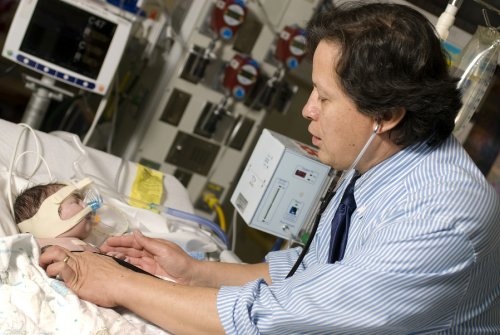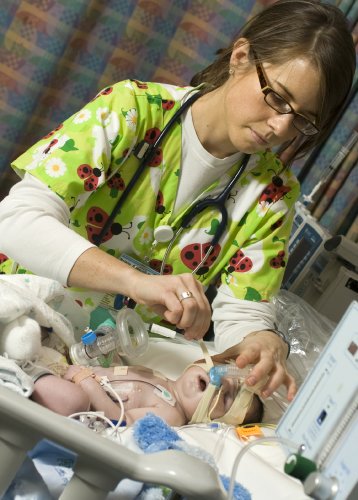
Mario Rojas, M.D., M.P.H., here examining Silas Roberson in the NICU, is studying alternatives to mechanical ventilation to aid premature babies with respiratory distress. (photo by Susan Urmy)
A lighter touch may help preemies breathe easier
When it comes to helping premature infants breathe, there is a love/hate relationship with mechanical ventilation.
Without it, many infants would die, but its use can damage tiny, immature lungs unprepared to handle the stresses the machine inherently causes.
A researcher at the Monroe Carell Jr. Children's Hospital at Vanderbilt conducted a study that suggests that a less high-tech and perhaps underutilized approach can work better for some babies.
The study, published in Pediatrics, suggests that early Continuous Positive Airway Pressure (CPAP) might be a viable first option for some babies born with respiratory distress than a mechanical ventilator.
CPAP looks like an oxygen mask, but it covers the nose, not the mouth. Adults with sleep apnea use it to prevent airway collapse during sleep. In premature infants, the effect is similar. While the baby breathes, the continuous airflow through the nose keeps the lungs from collapsing.

Natalie Gossum, R.N., attends to Silas Roberson, 24 days old, in the Pediatric Critical Care Unit. (photo by Susan Urmy)
The study's author, Mario Rojas, M.D., M.P.H, associate professor of Pediatrics in the Division of Neonatology, also said his findings could suggest an option to save more babies in developing countries.
“In the United States, CPAP is considered an inferior first-line method of ventilation assistance, so this study would have been very difficult to do in the U.S.,” Rojas said. “But our results showed that 74 percent of babies in this gestational age category with respiratory distress would not require mechanical ventilation if they got CPAP first.”
Mechanical ventilation is considered a reliable way to control a premature infant's breathing.
Currently in the United States, when an infant is very premature, a liquid called surfactant must be administered to prevent airway collapse, and the standard of care is to use a mechanical ventilator with surfactant administration.
The study involved 279 infants born at 27 to 32 weeks gestation and with signs of respiratory distress in eight medical centers in Rojas' native Bogotá, Colombia. Because expensive mechanical ventilators are less available in Colombia, many babies with respiratory failure there, and in other developing countries, die without respiratory support.
Within an hour of birth the babies were placed on nasal CPAP and randomly assigned either to get immediate administration of surfactant or not.
The babies in the study did well on nasal CPAP, and even better with early surfactant. But Rojas said an important finding was that the further along babies were in gestation, the less likely the need was for mechanical ventilator use.
Rojas said this could signal to doctors in the U.S. that less invasive nasal CPAP with early surfactant could keep many babies off of mechanical ventilators, reducing the potential for lung damage.
The study also indicated that early use of surfactant, within the first hour after birth, can reduce the side effects of ventilation, like pneumothorax.
“This research is important in the U.S., to prevent some chronic lung damage caused by mechanical ventilation and keep health care costs down,” Rojas said.
“But it is especially powerful information for developing countries. From a cost-benefit ratio, you can get a CPAP machine for less than $1,000 versus a ventilator for many times that amount. If this became the standard of care, many more babies could be saved.”













